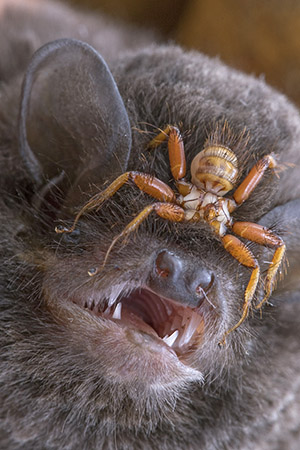To the dismay of cheesy joke aficionados everywhere, a fly without wings is not called a walk.
It’s called nycteribiidae.
Also known as bat flies—named after their preferred host—these tiny parasites belong to the true fly superfamily, Hippoboscoidea. Their flat, wingless bodies do not resemble common flies, which is why they are often mistaken for spiders.
Another cause of misidentification is their recessed head, and many species of bat fly only have rudimentary eye spots—tiny specks reminiscent of an arachnid’s beady eyes. But count their legs. We all know Charlotte has eight, and insects have only six.

According to Sarah Keartes at Earth Touch News, misidentification became viral back in 2015 when entomologist Piotr Naskrecki posted his photos of a bat with a “facehugger” stuck to its head. People claimed the creature was a spider, a tick, and even the result of photoshop. Alas, it was a bat fly.
In addition to being a true fly, nycteribiidae are genuine parasites. Males and females both consume blood, and live their lives almost exclusively on a host, to which they provide no mutual benefit. They are also observed transmitters of bat malaria.
Nycteribiidae were discovered in 1819 by George Samouelle, a curator in the British Museum of Natural History. Despite their long recognition, bat flies are not a widely known insect. Most of the 230+ species live in the tropics, inhabiting parts of South America and Central America, though specimens have been identified as north as Europe.
The oldest known bat fly on record was found encased in amber in the La Búcara mine in the Dominican Republic. It was studied by George Poinar of Oregon State University, as reported by Live Science:
“Based on other fossils encased in amber from the La Búcara mine, Poinar estimates that the bat fly got trapped 20 million to 30 million years ago, though the range could be as large as 15 million to 45 million years ago. Given that bats go back about 50 million years, the find means that the flies have been attacking bats for at least half the time they’ve existed, Poinar said.”
So what do you call a fly with no wings AND no legs? A roll! Until entomologists ruin that one for us too.